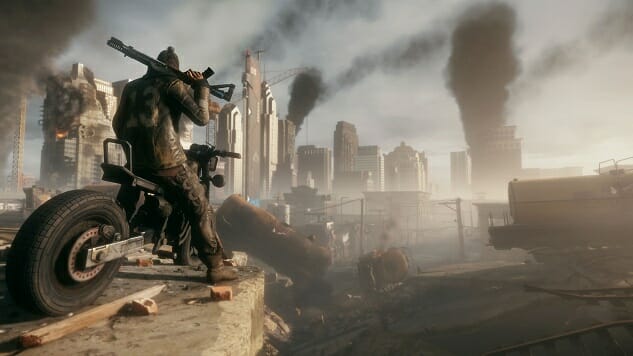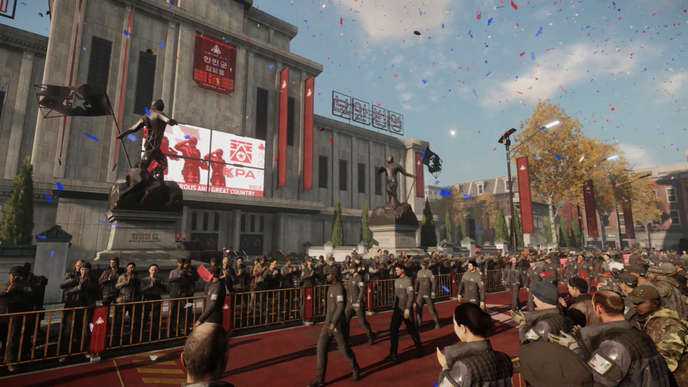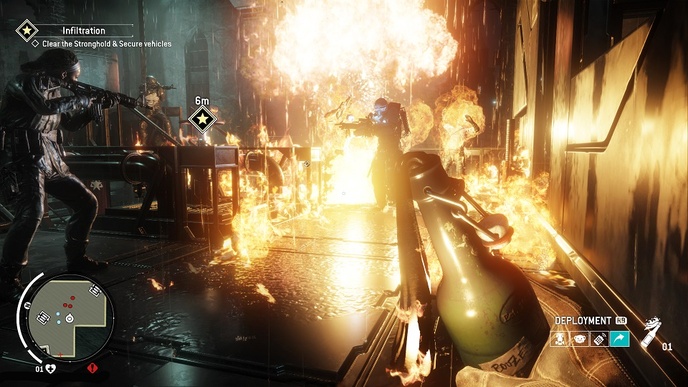Homefront: The Revolution is the Gus Van Sant’s Psycho of Games

In 1998, Gus Van Sant directed a shot-for-shot remake of Alfred Hitchcock’s Psycho. The film often gets talked about as a formal experiment, and Van Sant treats it as something between that and a little inside joke. “I was sort of angry at Hollywood trying to remake movies,” he explained in 2009, “because it seemed like they would rob the screenplay and forget all the other inputs, whatever else existed.” So he remade everything, warts and all, to an extremely negative critical reaction.
Homefront: The Revolution, like Van Sant’s Psycho, rests somewhere between a faithful remake, an intellectual property cash-in, and a weird formal exercise in trying to replicate 2011’s Homefront. You might notice that there’s a strange tension here in that Homefront is not exactly the audience-grabbing, genre-bending, earth-shattering meteor of a media object that Psycho was and continues to be. At best, it was a rushed game with interesting ideas; at worst, it was a Call of Duty 4 imitator that couldn’t manage the charm or technical achievements of that franchise.
I tend toward the former when it comes to Homefront. I’ve played the game through multiple times, on multiple consoles, across several years. I’ve returned to it over again and again, and all of that weird focus eventually culminated in a video that I made in 2015. With all that good I see in the object, it is important to note that I am a realist when it comes to the game. It is marred by technical issues, falls apart as a narrative, and delivers an less-than-stellar experience mechanically. I imagine that people who bought it at retail were very, very bummed about it. The game is not its best self.
It’s unclear if Homefront is meant to be a reboot or a continuation of the Homefront universe introduced to us a few years back, but it really doesn’t matter all that much. We’re told that the North Korea of this fictional universe is a kind of conglomerate of what happened in the latter half of the 20th century in China, Japan and North Korea. Therefore, this North Korea is a technologically advanced manufacturing powerhouse with a strong military ethic, and after acquiring an immense amount of American debt, they exploited a backdoor in military and civilian equipment in order to invade the United States under the pretense of humanitarian intervention. You’re a freedom fighter, Ethan Brady, fresh out of some terrible massacre in Washington D.C. and now here to provide muscle in the fight for liberty in Philadelphia.
The reason for so much remake talk up above is that the confusion between “reboot” and “sequel” in Homefront: The Revolution makes for a strange experience for someone familiar with the first game. Without spoilers, I can say that plot point for plot point, the same series of occurrences happen here just as they did in the former game. There’s a character who warns you against the excesses of war. There’s one who cannot help but be consumed by it. There is a heroic sacrifice. Some people save the day. None of those things are in order, and in this yet-again American revolt story, none of those things should be surprising.
From a narrative perspective, the lack of surprises is what hurts The Revolution the most. I can tell you all of those grand maneuvers up above because all of them are so standard in the action genre that they functionally tell you nothing. The problem isn’t only in the grand and generic, though—it’s also in the micro. Take, for example, the hyperviolent sadist revolutionary Dana Moore. Do you know why she’s so hellbent on murder and revenge? She was sexually assaulted in some way by the puppet Mayor that the North Koreans installed in Philadelphia. That’s the extent of her story. The same goes for Jack Parrish, our generic strong-jawed masculine good buddy who spouts libertarian rhetoric peppered with an occasional “together!” so we know that the revolution is good and not just individualist warmongering. Rounding out this crew is Sam Burnett, a doctor with a slew of clinics that he is trying to open, who is constantly being bullied by his fellow resistance members. Of all the characters, he seems to be the least predictable until his desire to save lives causes him to utter the phrase “I’d rather be a good man enslaved than become a monster in the name of freedom.” I don’t know who wrote this line, but putting it into the mouth of a black man in America in a game released in 2016 has some serious problems.
It seems clear that the developers of Homefront: The Revolution knew that they wouldn’t be able to replicate something like the streamlined, set-piece action modes of the Call of Duty franchise. Some of that choice might not have been a choice at all as the development of The Revolution was a rocky one, getting kicked from different studios and publishers due to bankruptcies and intellectual property sales. Wherever the design emanates from, the game manages to sidestep the CoD landmine by running headlong into the design concepts of Far Cry, Dying Light and other first-person games set in open worlds. The North Korean forces patrol the streets and occupy various places in the world, and it is your job to clean up the streets by routing the enemy forces from the factories, pharmacy buildings and whatever else they have posted snipers and infantry in. There are nodes, and going to the nodes and shooting people there will turn part of your world map from red to blue. You’re winning the war.
While I think there’s a rush to reduce this game to a copy of Far Cry with worse shooting mechanics, the game’s developers clearly knew that their team size, resources or available time would not allow them to compete the with Ubisoft’s or Activision’s flagship blockbusters. Only around half of the game’s areas are governed by the “go there, kill enemies, unlock map” design. Other parts of the game take place in occupied areas full of civilians, and the player has to take on the role of the saboteur in order to sow discord, create secret bases and establish watching positions for the inevitable revolution. I truly think that these parts of the game are excellent, and if Dambusters had committed 100% to an urban guerrilla war open world game I would be much happier with the entire product.
In these sections, the player can free prisoners, assassinate commanding officers, blow up supplies, do jumping puzzles to unlock bases, and quite a few other things in order to strengthen the resistance from the inside. In addition to this, you have to keep your gun out of sight, and avoiding scanners (a kind of security camera) and soldiers becomes imperative. It encourages some real cat-and-mouse that I found much more engaging than the lackluster shooting that the game offers in its more action-based sequences.


